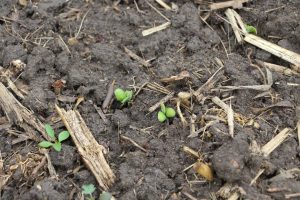Cold Weather Impact on Soybeans
By Dr. Laura Lindsey, OSU Extension, Adapted from C.O.R.N. 2020-13; and by Mike Staton, MSU Extension
Now is the time to scout your soybean fields for frost or freeze injury. In Ohio, between May 9 and 10, temperatures were as low as 26°F with some areas even receiving snow. The effect on soybeans depends on both temperature, duration of low temperature, and growth stage of the plant. The soil can provide some temperature buffering capacity, especially if soil is wet. Water is approximately 4x more resistant to temperature changes than air or dry soil, and thus will buffer the soil from experiencing large temperature changes as air temperatures drop. Deeper planted seeds may also be more resistant to large temperature swings.
Imbibitional chilling may occur in corn and soybean seeds if the soil temperature is below 50°F when the seed imbibes (rapidly takes up water from the soil, usually 24 hours after planting). Imbibitional chilling can cause reductions in stand and seedling vigor. If seeds were planted into soil at least 50°F (and have imbibed), the drop in temperature is not likely a problem if the plants have not yet emerged from the soil.

The growing point of soybean is above the ground when the cotyledons are above the soil surface. If damage occurs above the cotyledons, the plant will likely recover. If damage occurs below the cotyledons, the plant will die. Look for a discolored hypocotyl (the “crook” of the soybean that first emerges from the ground), which indicates that damage occurred below the cotyledons.
It is best to assess damage to plants or seeds 48 to 96 hours after the drop in temperatures, as symptoms may take a few days to appear. Additionally, cold temperatures slow GDD accumulation and may further delay crop emergence.
The recent low temperatures of a week ago may have damaged emerged soybeans and will probably lead to reduced stands in those fields, according to Mike Stanton, Michigan State University Extension Educator. “The extent of the damage will not be known until about one week after the low temperatures occurred because the plants in the photo may still produce new growth from the axillary node located at the base of the cotyledons. If new growth is not detected from the main growing point or the axillary node at the base of the cotyledons after a week has passed, the plants are no longer viable.”
When poor soybean emergence and thin stands occur, producers need to make timely and informed replant decisions. Accurately assessing your soybean stand and diagnosing the cause of the emergence problems are the first steps in the process. Once the existing stand has been determined, the following information may help producers make an informed replant decision. 
Forty-eight planting rate trials were conducted in Michigan from 2015 to 2019. “The data shows that thin soybean stands can produce surprisingly high yields. However, there were exceptions as yields from the 80,000 seeds per acre planting rate were reduced by more than 4 bushels per acre at 12 of the 48 sites (25% of the time). Four bushels per acre is the approximate breakeven yield loss for the 80,000 planting rate given current seed and crop prices making the 80,000 rate less profitable than the 160,000 rate at these sites. At three of these sites, the yield loss in the lowest planting rate was more than 7 bushels per acre. None of the varieties in the trials were thin or straight-line plant types,” said Staton.
“Soybean agronomists have identified 100,000 plants per acre in narrow rows and 80,000 plants per acre in 28- and 30-inch rows as the minimum plant stands required to produce optimum yields,” said Staton. “However, the data from MSU Extension shows that stands of 60,000 to 70,000 plants per acre can produce high yields. Also, realize that soybean yields decrease by 0.3 to 0.4 of a bushel per acre per day when planting after the first week of May.”
Staton urges producers to consider this information, and to refer to an excellent publication from the University of Wisconsin, “Think Twice Before Replanting Soybeans,” when making replant decisions.
The case for keeping thin stands becomes even stronger for fields having a history of white mold. The lowest planting rate increased soybean yields by 5 bushels per acre and income by $80 per acre over the highest planting rate at two sites infested with white mold.